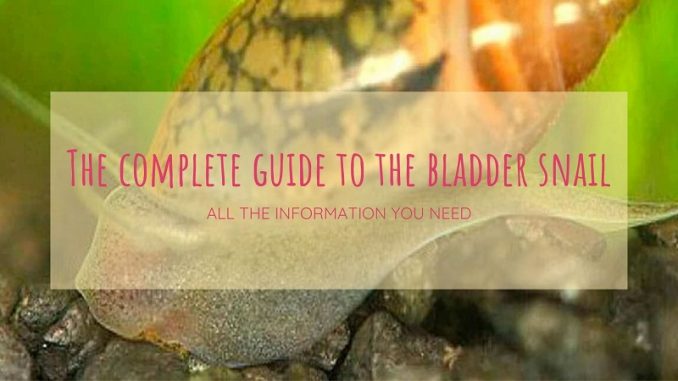
Have you ever come home with some new plants or a new fish for your freshwater tank, and then noticed some uninvited guests a few days later? These party crashers are probably bladder snails, and they can be considered both pests and helpers.
We have collected all the information you need about bladder snails, whether you are welcoming them into your tank or trying to banish them. We’ll cover things like the snails, non-fish tank mates, advantages and disadvantages of having them around, what they eat, how they reproduce, and much more.
TABLE OF CONTENTS
Bladder Snail Facts & Overview
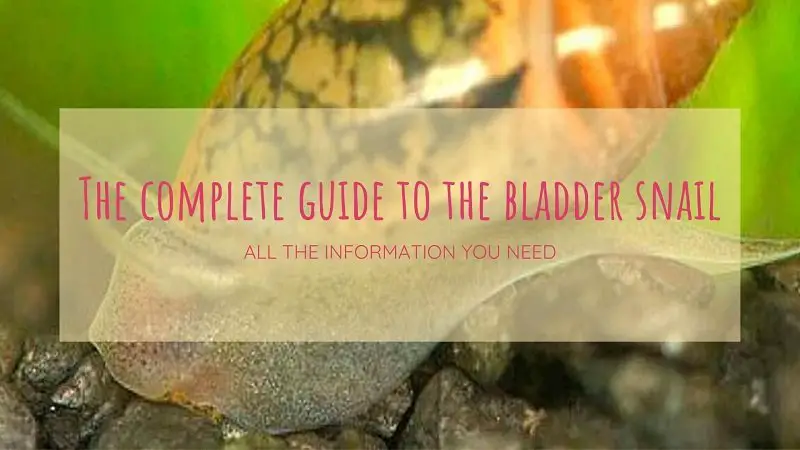
| Category | Rating |
| Care Level: | Very easy |
| Temperament: | Peaceful |
| Color: | Greyish with yellow spots |
| Lifespan: | Up to 2 years |
| Size: | About 1/2 inch |
| Diet: | Omnivore/Algae |
| Family: | Physidae |
| Minimum Tank Size: | Any size |
| Tank Set-Up: | Freshwater, pH 7-8 hard waters |
| Compatibility: | At-risk from aggressive fish |
You might be surprised when you see a bladder snail, or Physa acuta, in your freshwater tank, especially since you did not buy one! Bladder snails hitch rides on plants and any other decorative features you purchase for your tank.
The bladder snail is known as an invasive creature because of its ability to reproduce rapidly, and due to the fact that aquarium aficionados do not usually buy them. However, just because they come along for the ride home doesn’t mean they are pests. We’ll talk about the benefits and drawbacks of keeping these freshwater snails in your tank a little bit later.
The bladder snail is in the Gastropoda class and part of the Physidae family. These tiny gastropod mollusks are only about 1/2 inch in size. Although they are aquatic, they breathe air.
The bladder snail is a peaceful creature with a ravenous appetite. As a member of the Physella acuta species, the bladder snail has a sinistral shell, which means that if you hold the aperture toward you with the spire pointing up, the aperture will be on the left-hand side.
The origin of the bladder snail is not fully understood, and there are conflicting theories about origins in Eastern Europe and in Central America. Today, bladder snails are common in the European countries of Belgium, Croatia, Italy, the Czech Republic, and others.
They are also found in abundant numbers in Africa and the Mediterranean, and in the United States, in Maryland, New Jersey, Tennessee, and Virginia. The only place we do not find bladder snails is Antarctica.
Bladder snails live for up to 2 years and prefer still water that’s between 64 and 84 degrees. They are hermaphrodites, meaning they have both male and female sex organs. (More on that later in the Breeding section.)
Typical Behavior
Bladder snails are pulmonary, or air-breathing, creatures, and swim upside down at the surface of the water to breathe air. If the snail senses danger, however, it will empty the air from their respiratory system so that they can retreat to the safe bottom of the tank.
The other way they have to protect themselves is by flicking their shells back and forth quickly.
Unlike some other aquarium biome helpers, bladder snails crawl through the water, rather than digging. They move pretty fast, too!
Appearance
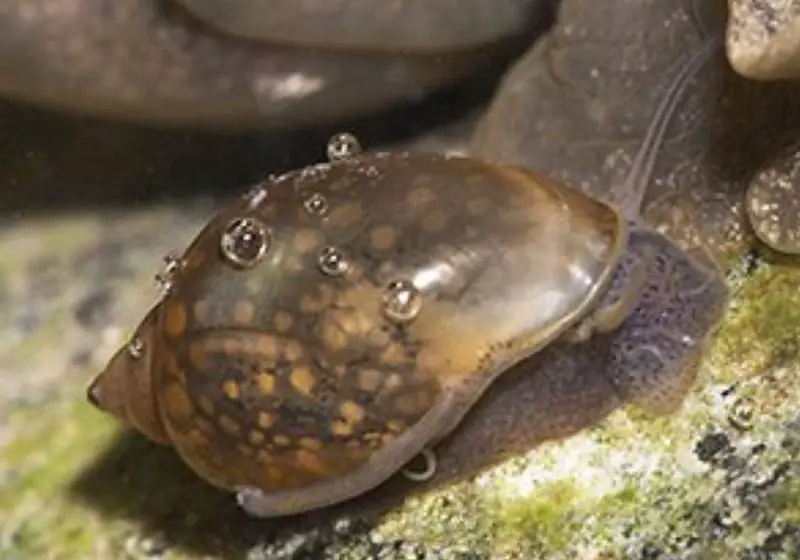
Some people have trouble telling the difference between the bladder snail and a regular pond snail – some defining visible variations between the two include the shell color, shell form, and tentacles. Bladder snails are known for their yellow spots and transparent shell, while pond snails are brown.
In addition, bladder snails, as we mentioned before, are sinistral; that is, their shells spiral to the left. Pond snails, on the contrary, are dextral; that is, they spiral to the right. Finally, you’ll notice that the bladder snail has short, thin tentacles, while the pond snail has triangular tentacles that are thick. At the base of those thin tentacles, you’ll find the bladder snail’s eyes.
The bladder snail’s shell is shaped like an egg with a pointy tip. It does not have the operculum, or trap door, that allows other snails to protect themselves from predators. There are 4 to 5 whorls on the average bladder snail shell, and the thin shell is translucent.
The bladder snail’s mantle is colorful and has yellow-orange spots.
Diet
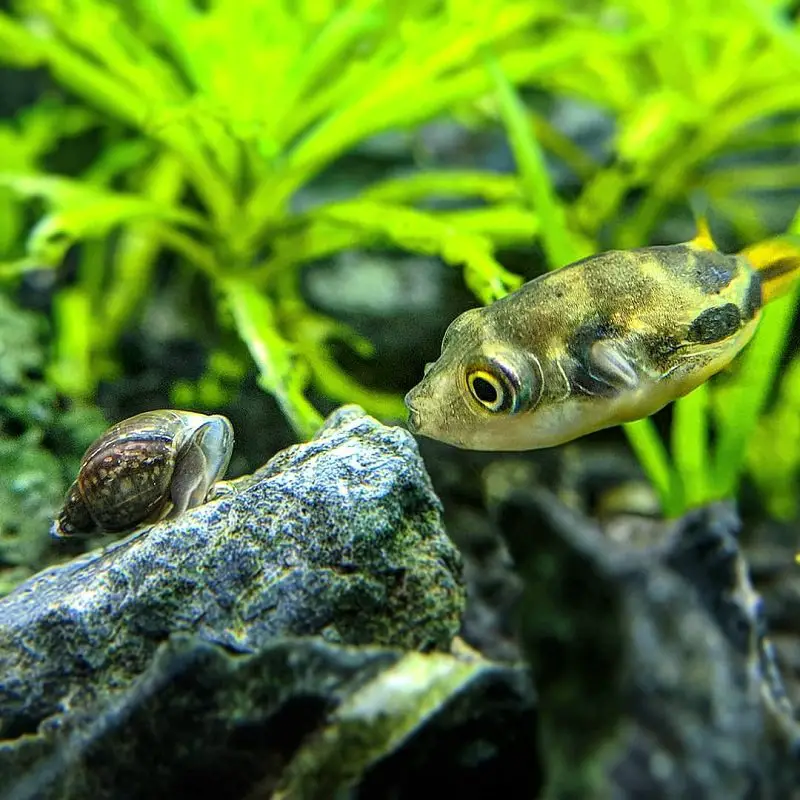
Bladder snails are voracious eaters and are constantly snacking. And they are not picky eaters, either. They are omnivorous and will eat the parts of plants, diatoms (algae), meat, insects, and vegetables that are dying and decaying. They will also eat leftover fish and shrimp food, as well as any other debris and waste in your tank.
With such a healthy and varied appetite, these bladder snails seem like the perfect addition to your tank’s biome. And they are, but if they get too much to eat, you run the risk of a bladder snail infestation. (More about that later.)
Bladder snails are not interested in your healthy aquarium plants – they will eat anything decaying on your plant; they are like tiny landscapers for your tank.
Habitat and Tank Conditions
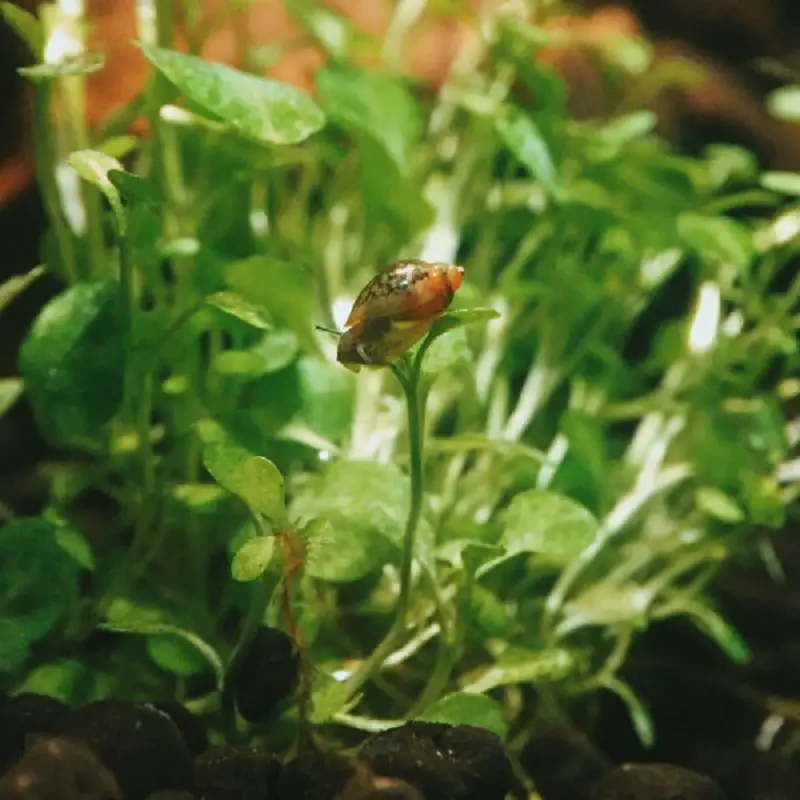
Bladder snails are able to thrive and resist death in even the worst of conditions. Most of the conversation here revolves around how to control the number of bladder snails in your tank.
Bladder snails show a preference for slow-moving, warm water, and are not daunted by dirty water. Remember, bladder snails graze on algae, decaying plants, and fish waste, so dirty water is actually a food source for them.
Tank Conditions
Bladder snails can survive in both hard and soft water, and in varying levels of pH. In fact, in the wild, they endure sewer life, so they’ll do just fine in the comfort and safety of your controlled tank.
They also flourish in a wide range of comfortable temperatures and can reproduce in waters from 59-86 degrees F. However, the bladder snail does see overall better reproductive rates in cooler water and is somewhat compromised at the higher range.
One study* showed that in lower (59 degrees F) temperatures, bladder snails reached sexual maturity later (at 34 days), and had a high reproductive rate, with about 115.6 eggs during the time studied, whereas at higher temperatures (82 degrees F), bladder snails reached sexual maturity much earlier (at 18 days), and had a lower reproductive rate, with about 24.6 eggs during the time studied.
Further contrasts can be seen with the lifespan and size of the bladder snail offspring. The snails bred in the 59 degrees F water lived an average of 403 days and had an average length of .24 inches. The bladder snails bred in the 82 degrees F water, on the other hand, lived an average of 87 days and had an average length of .18 inches. The cooler water offspring lived longer and grew larger than hotter water offspring.
What Size Aquarium Do They Need?
Bladder snails do not have a tank minimum or maximum requirement; they are going to grow and reproduce pretty much anywhere. Any tank size considerations will be for the fish you’ll be housing in your aquarium.
It would, however, be reasonable to deduce that a smaller tank with more and larger fish would more quickly produce the water and waste conditions that would encourage increased bladder snail populations.
Calcium
Calcium is necessary for the growth of the bladder snail’s shell. If your tank is a low-calcium environment, the bladder snail will have limited growth and reproductive rates, and their survival will be threatened.
If you are hoping to use bladder snails to clean your aquarium, you can add cuttlefish bones or eggshells to your tank.
Freshly hatched bladder snails have soft shells and will immediately start looking for sources of calcium to harden their shells.
Too many bladder snails or not enough?
We’ve already established that bladder snails sneak their way into your aquarium; most likely you did not buy them to add to your tank and did not even notice that they were there – until you did.
Their Uber driver was likely a plant you bought for your tank – or maybe some of their eggs got caught in the net used to deliver your new fish.
We’ve already mentioned that bladder snails will keep eating as long as there is food around. If you’re overfeeding your fish, you’ll end up overfeeding your bladder snails (more fish food equals more fish waste and uneaten food, which equals more food for bladder snails, which equals a surplus of bladder snails.)
If you feed your fish high-quality food in reasonable amounts and keep the tank water clean to reduce waste, you should be able to keep your bladder snail population small enough to help clean the aquarium without overcrowding it. Warning: if you do have too many bladder snails, you risk a clogged filter.
Too many algae mean too many snails
In addition to overfeeding bladder snails, the waste from overfeeding fish leads to algae growth, which weakens and threatens the life of aquarium plants; at that point, the bladder snails will eat the now unhealthy plants.
If you’re seeing an abundance of bladder snails, that’s a sign that your tank needs attention and quick action.
What to do if you have too many bladder snails
If you find yourself with a few too many bladder snails, there are a couple of ways of trimming the population.
Put out romaine lettuce traps: This lettuce is a favorite of the bladder snail, so a lettuce leaf at the bottom of the tank will attract them. You can lift the leaf with the snails right out of the tank.
What then? You can give the snails to a fellow aquarium keeper for their fish that feed on bladder snails; you could also drop them off at a pet store.
Buy a predatory fish: Add a feeder fish to your tank that will look on your bladder fish as a tasty snack. Read on for a discussion of these feeder fish.
Tank Mates
Usually, we discuss tank mates as friendly roommates. But in the case of bladder snails, tank mates may very well be feeders that will control the bladder snail population and for whom the bladder snail provides sustenance.
Loaches, betta fish, pufferfish, assassin snails, and crayfish are predatory creatures that will eat bladder snails.
Yoyo Loach Fish
Yoyo loaches, which get their name from the yo-yo markings on their back, are sociable fish that get along with other fish in the aquarium (except sometimes when they are in a group). They have a nice disposition, and they just love to eat bladder snails.
Loaches get pretty big, so you’ll need a larger aquarium for the loaches to thrive.
Betta Fish
Betta fish are known for being aggressive, a contrast to their appearance. Betta fish are carnivores and will eat bladder fish, but since the betta is a smaller fish, it will eat the baby bladder snails and eggs.
Green Spotted Pufferfish
The Green Spotted Pufferfish is another aggressive fish that is anything but sociable. They will eat anything that is smaller than it.
Pufferfish love the crunchy shell of the bladder snail, and the chewing is beneficial to their jaw.
Add multiple pufferfish with caution; they are so ornery that pufferfish might eat their own mate if you bring in more than one.
Assassin Snails and Crayfish
Although these aren’t fish, they’re both found in tanks and both eat bladder snails.
Assassin snails, as the name suggests, will eat their own. They’ll surely rid your tank of a bladder snail infestation, but only if you’re patient. They work slowly.
Crayfish prefer the smaller and softer bladder snails; if the shell is too hard and the snail too big, they’re not interested.
Note: Assassin snails and crayfish are often hunted by other aquarium creatures, so they might disappear before they have a chance to eliminate your bladder snail problem.
Breeding
Bladder snails, like other asexual invertebrates, often choose to behave as one sex or the other. Since they are hermaphrodites, they can switch to behaving like the other sex, or fill both roles.
As hermaphroditic freshwater snails, bladder snails have a sperm storage organ; the possession of both male and female reproductive organs allows them to reproduce through both internal self-fertilization and through cross-fertilization (mating).
If a bladder snail doesn’t find a mating partner, they will self-fertilize internally, particularly if they feel threatened and want to propagate before getting killed. Self-fertilization is not ideal as the resulting offspring have a lower survival rate. Even without feeling threatened, a bladder snail will resort to self-fertilization after eight weeks of not finding a mate.
Most bladder snails, however, choose the more traditional method of breeding. In fact, a bladder snail couple will usually mate upon entering an aquarium. One bladder snail climbs onto the shell of another and crawls to the female reproductive organ, a process that can last a half-hour.
Somewhere between 28 and 42 days of life, a bladder snail reaches female maturity; male maturity occurs before that. The bladder snails are about 1/4 inch long at the point that they reach sexual maturity.
Interesting fact: Gender preference in a bladder snail can switch even in the middle of a breeding session.
Bladder snails lay capsules of eggs; each capsule holds 10-40 eggs and the eggs hatch 6-7 days after being laid. The eggs are transparent, and 70-90% hatch into baby bladder snails that are about 1 mm long.
Are Bladder Snails Suitable for your Aquarium?
In the end, the choice is yours about whether you want the help of a bladder snail in keeping your aquarium clean, or if the extra work of making sure they do not overrun your tank takes the option off the table.
Bladder snails are good-natured scavengers that can help keep your aquarium in fine shape, provided you do your part to keep the tank clean and feed your fish appropriate amounts. However, since they are efficient breeders (see above), you may have to put in some effort to make sure that the bladder snail population in your tank doesn’t spin out of control.
Adding a predatory fish that eats bladder snails like whales eat krill can be a good solution to excessive bladder snails. However, it’s hard to find the right fish, since something that is predatory to bladder snails might also see your other fish as lunch.
Because of their ability to survive in harsh conditions, bladder snails are present in nearly all freshwater aquariums. They are prolific breeders and their eggs have a short gestation period, so they can quickly and effectively overpopulate your tank if you’re not paying attention.
However, since they’re useful to the aquarium biome, eating algae, decaying plants, fish waste, and extra fish food, it’s good to have some of them around.
Do you think bladder snails are a menace or a helpful addition to your aquarium? Let us know why in the comments below…
*BRACKENBURY, THERESE & Appleton, Christopher. (1991). Effect of controlled temperatures on gametogenesis in the gastropods Physa acuta (Physidae) and Bulinus tropicus (Planorbidae). J. Molluscan Stud.. 57. 10.1093/mollus/57.4.461.

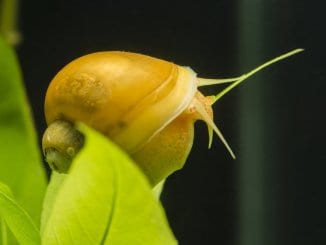
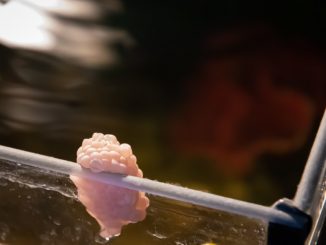

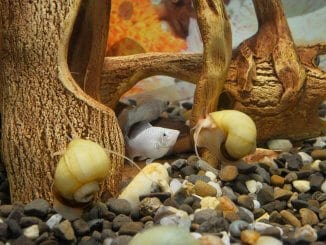
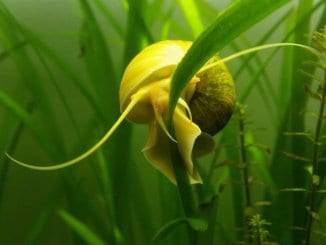
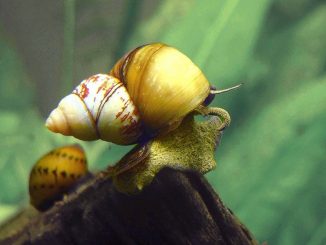
I love my bladder snails. I have a breeding tank for them. It has our pleco which grew out of the community tank and got his own. It also has a betta fish. I have to say that my betta fish must be lazy because my bladder snails are thriving. I just let the snails go crazy in that tank and then I take the big ones and put them in my community tank. My community take has a catfish who loves algae wafers so there is always algae popping up some where.
Thank you for this article. I found the water temperature information interesting. It makes sense why they don’t take over my community tank bc we kept that pretty warm for the cichlid. I feel like people don’t care about the snails but I love them. I watch them speeding around the tanks all the time. And always eating. Lol
In my experience, bladder snails are a double edged sword, for sure! Useful article. Thank you :)
Hi Robert, thank you for this article it has been very helpful in my research, after discovering a few of these little guys in my tanks. To be honest I’m excited they arrived, I know most will see them as a real nuisance, but these guys are the price most of us pay for stocking our tanks with healthy and beneficial live plants (lol). I had an outbreak when I first started keeping fish 3 years ago, and in my haste removed them all successfully. This time I’m looking to manage the populations in my 30 & 10 gal tanks with regular cleaning & monitoring. The 10 gal had my betta bud, so I’m hoping he will enjoy the treat of live food, I’ve got 3 mature snails visible in that tank right now. The 30 gal, I’m hoping my fish will help manage the snail populations, however I’m not relying on that as its a neon tetra and cory cat tank, neither seem identified as helpers in snail management but we’ll see. Regular cleaning I’m hoping will keep it under control. again 3 visible adult snails in that tank too. Wish me luck!
I am the kind of person who suffers mentally when I have to kill living things, so the growing problem of too many bladder snails in my aquarium is weighing on my mind. I may have to introduce an assassin snail and come to terms with the circle of life.
I feel your pain @Sheogorath! 4 months on, and I now have many, many, too many more than I can handle. BUT THEY’RE SO COOL!
I’ve re-read this article and realize I need to feed my tank less to manage the snail population. Because I just can’t bring myself to kill any of these beautiful creatures I’m setting up a 5 gal tank just for them. I’m moving all the nice big ones into there and will do better in food & water management to ensure my population doesn’t spike again. This tank has some external spider plants and African fern’s with roots growing into the water, and then there is hornwort floating in there too for food.
@Shegorath, have you considered putting an add on your local kijiji offering snails for those with fish that like snail snacks? Just a thought to help you with your population management :)
I can’t for the life of me keep them alive, everyone keeps saying I’m over run with them! I’ve been trying for 6 months different tanks ect they all die! So bumming me out.
How long are they living before they’re dying? A few days? Weeks? Hours? How many do you think you have just an estimate?
Why do my bladder snails start to have white
scratches on their shells? Anyone knows?
So I just noticed this today too. I do not think they are scratched, but rather its body wrapping around the shell in such a way that it appears there are 3 long white scratches. It looks like king triton’s spear is emerging from my snail. So weird!
Thanks for the great article. I just found one in one of my 20 gal tanks. I’m going to try to control the population. It is speedy and fun to watch.
I discovered a new bladder in my tank today. He grew up while I was on vacation for the last week. My first impression was “oh no!” I had rinsed all my new plants in a bleach solution to avoid this and I still got snailed! Anyway, after reading this article and learning a bit more about these little guys (they do move rather quickly don’t they) I am enjoying playing where’s Waldo, my new name for my snail. I hope he/she does not turn into a Waldo (or Waldet?) parade in my tank. This little bugger ate a large piece of flake food so fast I though he/she would have a stomachache. I can also see his/swe heartbeat. At least I think that is a heart beating I can see through the semitransparent shell. The really interesting thing is when I take picture of the little guy (or girl) I see the distinctive coloring on the shell but when I look with my naked eye I just see a semitransparent shell with a small opaque swirl at the end. I keep my tank warmish (78), I run with soft water so the calcium is rather low. I try to keep the water at about 3 degrees of hardness. I assume this means my calcium is low. I put hard water in my ATO (automatic top off) to add some hardness as water evaporates as my software water is pretty soft and I need to try and help my plants with some minerals. I LOVE the fact this little guy is going to not only clean up the mess in the tank it is going to trim my plants. How awesome is that. I have a java Fern throwing off new little baby ferns and leaves will die off. I was worried about the mess of dead plant in the tank. I just hope it doesn’t over feed Waldo and cause a population explosion. I am running a neon tetra tank in a 10-gallon nano with a sump in the back. That sump might attract babies to feed on the guck back there. Adding a betta has always intrigued me. If I end up with a spike in snails it might just get me to add that betta to try and trim the herd (or a “rout”, “walk” or “escargatoire” of snails).
I just started a new tank after taking a while off and I never have a tank without bladder snails I always have bladder snails and ghost shrimp this new tank is a guppy breeding tank I also have a male crawfish hopping to put some bladder snails in with him once I get a few more
Hi! Love this article & everyone’s comments too, but I still feel doomed to continue to have the added chore each morning of ‘getting rid’ of the overpopulation I wake to find crawling all over the walls of our 20-gallon aquarium! We even bought the Assassin snails, 3 of them and can only find one now~ so am I to understand that Assassin snails kill/eat their own kind as well as any of the Bladder snails?